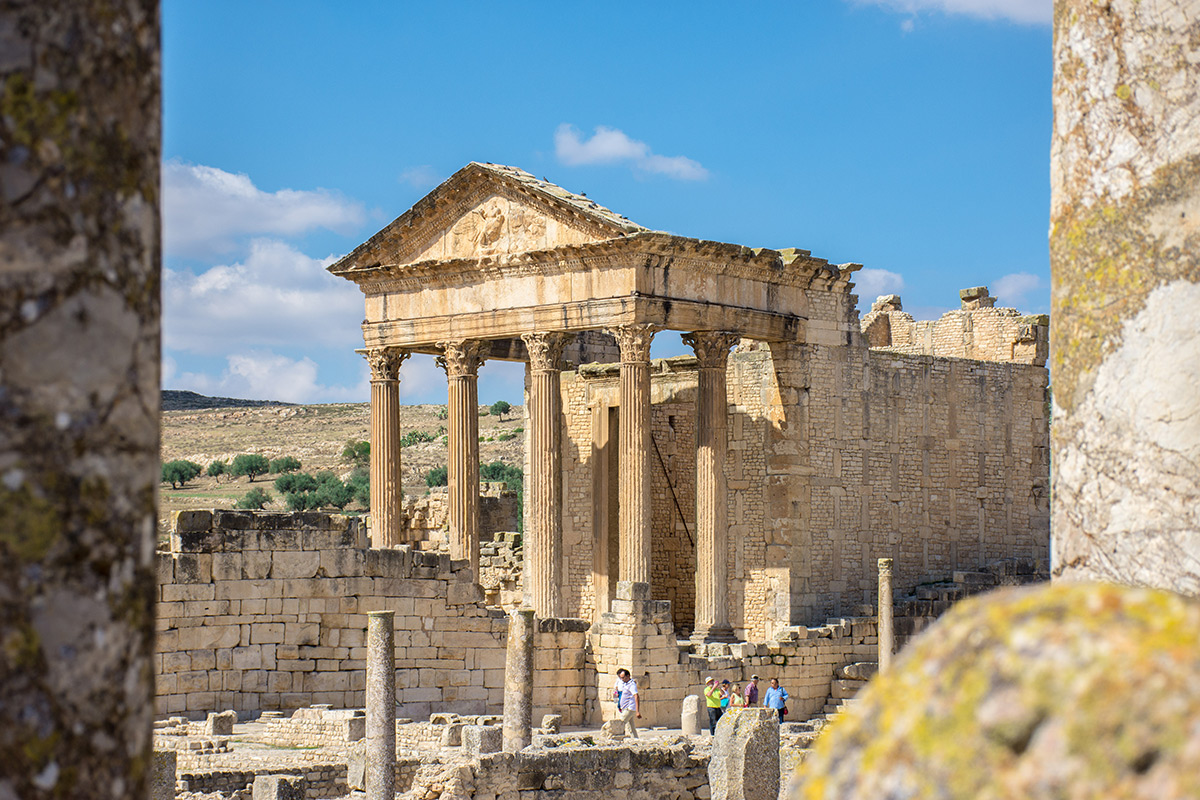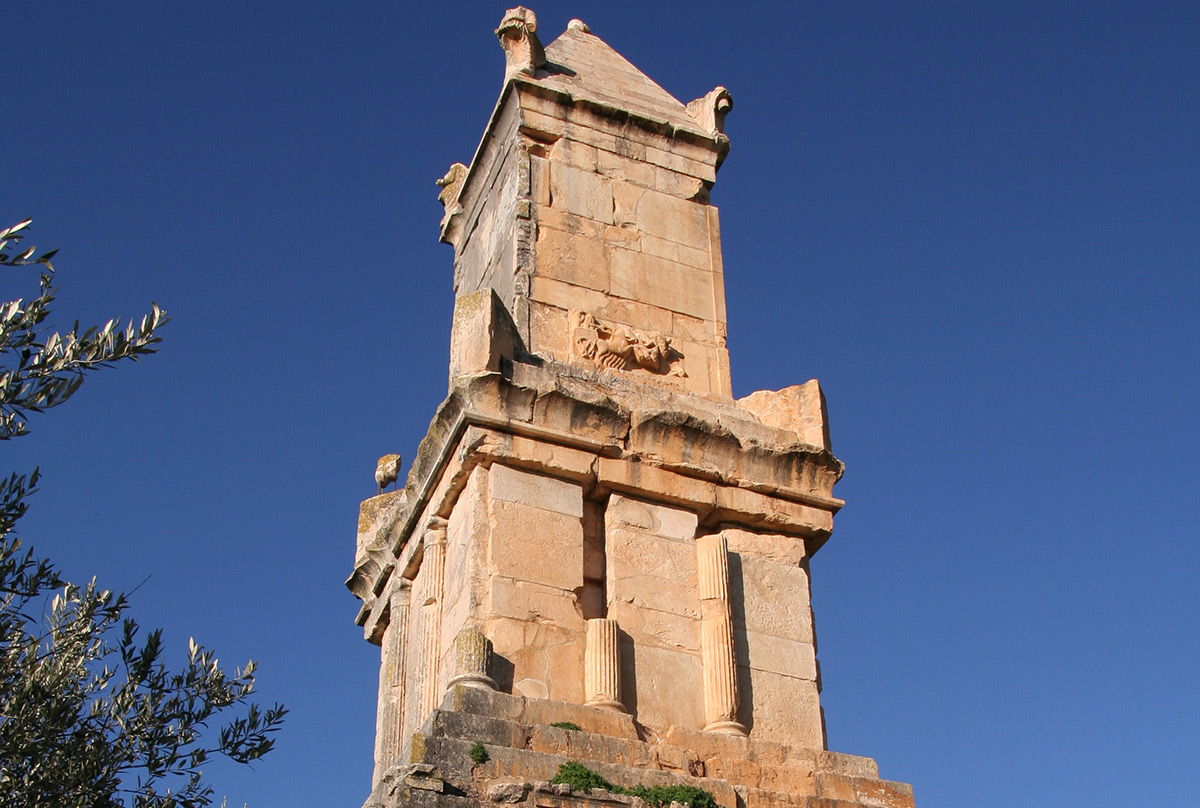The archaeological site, particularly impressive, extends across about 75 ha and presents the remains of a Roman town with all of its component parts. Apart from the opulent Roman monuments, it also displays many pieces of evidence of synthesis between the Punic, Numidian and Hellenic cultures.

Staggered over a hillside that finishes in an abrupt cliff, where the first foothills of the Atlas Mountains begin to appear in the northwest of Tunisia, the remains of an ancient city emerge, magnificently preserved with all of its component parts: temples, public institutions, monumental arches, houses, paved roads…
At its summit, the slender silhouette of a Capitoline temple. Below, a tall mausoleum in the form of a tower with an Oriental appearance.
The first expresses its devotion to the protector gods of Rome in all its elegance. The second reflects fidelity to the pre-Roman culture, as it is one of the rare known examples of Numidian royal architecture.
These two monuments together summarise the history of Thugga, the Numidian settlement, which went on to become a prosperous town of the Roman empire.
The Numidian people were the indigenous ancestors of the Berbers. Their civilisation flourished upon contact with Carthage, and they would form two kingdoms in the central Maghreb from the 4th century B.C onwards.
Sometimes allies of Rome, sometime enemies, they would finally see their territory incorporated into the Roman empire in the 1st century B.C.
This Roman god was the object of a particular form of worship in Africa as he was assimilated with Baal Hammon, the great Carthaginian god; in fact his temple was built precisely upon the site of a sanctuary of Baal, proof of the survival of the previous Numido-Punic culture.
Then the theatre appears, one of the best preserved in Roman Africa. Its hemicycle is especially beautiful.
Partly dug out of the hillside, with a capacity of up to 3,500 spectators, it is probably oversized for a town which never exceeded 5,000 inhabitants. It is evidence of the course of honours in which the rich families of Thugga took part in the 2nd century A.D: each wished to be the one to bestow the grandest monument upon the city.
The Capitol of Dougga is also an exceptional specimen. This temple dedicated to the Capitoline triad – Jupiter, Juno and Minerva – boasts tall fluted columns topped with Corinthian capitals, and a delicately carved triangular pediment burnished by centuries of sun.
At the other end of the site, the temple dedicated to Juno Caelestis is surrounded by a semicircular gallery held up by columns, a layout seldom seen in Roman Africa. There again, this temple signals the survival of pre-Roman religions as this divinity was none other than the heir of Tanit, the great goddess of Carthage.
Scattered at the feet of these monuments are countless remains: forum, shops, public squares, fountains, houses, and more than twenty other temples and other places of worship.
Not forgetting the thermae, a key component of the Roman lifestyle. Located in a region where water was plentiful, Thugga had three such establishments. The most imposing, the Antoninian Baths (formerly known as Licinian), presents a vast, harmonious and symmetrical architecture, where the different rooms – hot or cold, wet or dry… – are doubled for more comfort and for a better flow of visitors.

The form is similar to that of the famous Mausoleum of Halicarnassus, one of the seven wonders of the ancient world, and displays the Numidians’ proximity to the Hellenic world.
It once bore an inscription carved in two languages, Old Libyan (the local language) and Punic (the language of Carthage), today preserved in the British Museum. Constructed by Numidian builders in the middle of the 2nd century B.C., this high profile monument reaffirms the importance of this city, once a royal residence of the great king Massinissa, the uniter of Numidia and enemy of Hannibal.
The Dougga site stands apart in the way that it both shows the typical model of a Roman town including its most representative monuments, and the intimate interweaving with the pre-existing civilisation. The Roman forum was most probably placed over the former Numidian agora (public meeting place), and the remains of the temple dedicated to the Numidian king Massinissa were found at the base of the Capitol.
But the value of Dougga is also found in the extraordinary beauty of its remains that stretch across a lush landscape of olive trees and fields of wheat.
The Libyco-Punic mausoleum is a funerary monument most probably dedicated to a member of the Numidian royal dynasty. A spectacular twenty-one metres in height, it has preserved bas-reliefs depicting chariots pulled by four horses, and decorative fragments mixing Greek and Egyptian influences.
One of Dougga’s most beautiful buildings, the Capitol displays upon its pediment a bas-relief representing the apotheosis of Emperor Antoninus Pius being carried away by an eagle – a symbol of his admission amongst the gods. As in other buildings found in Thugga, the walls were constructed using the Punic technique of opus africanum (chaining apparatus).
The theatre of Dougga is representative of monument structures that were used for multiple purposes. The population of Thugga would gather there to watch shows but also for official ceremonies or political announcements. Its stands, terraced over a height of 15 metres, and a section of its stage colonnade have been preserved.
The temple of Juno Caelestis is designed according to an original blueprint, unique in all of Roman Africa. Standing upon a podium, it is surrounded by a closed semi-circular courtyard fringed by a portico. The form may have symbolised the crescent moon, an attribute of the Punic goddess Tanit to whom Caelestis was assimilated in Roman Africa.
The Antoninian Baths, established in rugged terrain, required major earthworks. The entrance overhangs, and the different spaces (frigidarium, tepidarium, caldarium, sudatorium, laconicum, palestra) are repeated symmetrically to form a vast complex.
© G. Mansour, “Tunisie, patrimoine universel”, Dad Editions, 2016
The site of Dougga was declared a UNESCO World Heritage Site.
More about the World Heritage Sites in Tunisia